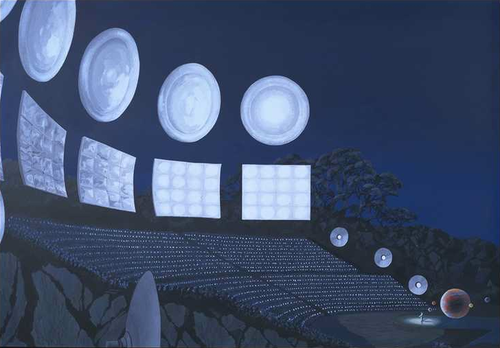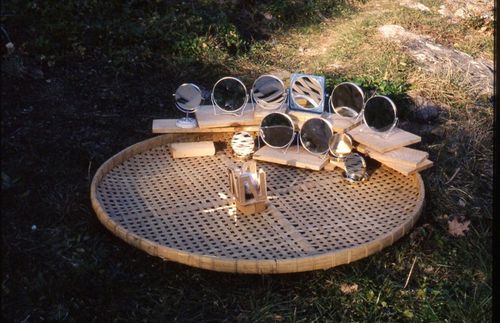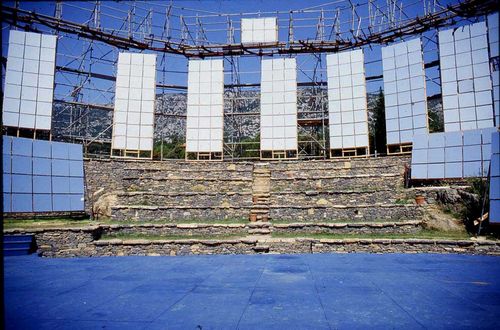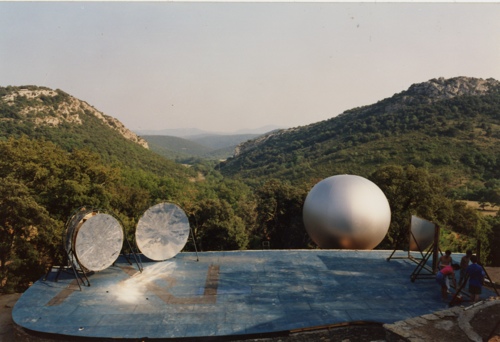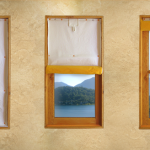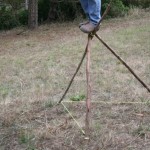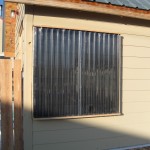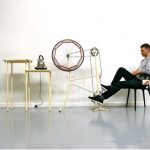Under good climatic conditions and using specific technology, the full moon can be a powerful source of light.
Using technology inspired by solar energy concentrators, the “Full Moon Theatre” lights its performances using only moonlight. Moonbeams are collected, concentrated, and focused on stage.
The original Full Moon Theatre was built in Southern France and their plan is to create twelve Full Moon Theatres worldwide.
The Full Moon Project is the brainchild of French opera director Humbert Camerlo. Camerlo got the idea in 1987 and initially tested it by assembling a group of shaving mirrors that focused the light of the moon onto a small sculpture in his garden in Southern France (picture below). Four years later, in 1991, the construction of a full-size theatre began, in collaboration with Irish engineer Peter Rice. Rice would be involved in the project until his death in 1992, after which his disciple, Nicolas Prouvé, took over the collaborative role.
Like most good inventions, the Full Moon Theatre was born out of necessity. Camerlo was setting up an interdisciplinary theatre lab, but had no money to pay for a professional lighting installation.
The original moonlight theatre, 1987. Picture: The Full Moon Theatre.
Performances lit by moonlight are, of course, limited to certain nights when there is both a full moon and a clear sky. When these opportunities occur, however, we have at our disposal a lighting source that is potentially better than artificial light. Moonlight has a similar quality as sunlight.
“We can see at night during the full moon phase reflecting sunlight but we do not have a strong visual accuracy. Under good climatic conditions, the light power of the Moon is 1 on 100 000 to the sun light power. In the same time moon light has practically the same colour temperature to the sunlight. The challenge was to find optical systems to multiply the power of the Moon in order to light a performance and to reveal costumes colours.”
Reflectors
The development of the reflectors has been an on-going process. Three types were made: “Keplers” and “Archimedes” designed by Rice’s teams in London and Paris, and “Copernics” designed by Camerlo. The reflectors track the moonbeams, amplify them and reflect them onto the stage. Some of the reflectors also track the actors on stage.
Moonlight collectors. Image: The Full Moon Theatre.
Beyond the symbolic or metaphoric use of the moon to light a performance, the Full Moon Theatre laboratory has prompted ideas for experimental work in architecture or even in town planning. The project wants to promote the development of technology for the use of natural light in the visible fringe of the solar spectrum. Underground areas such as subway stations, for instance, could easily be lit by sunlight during the day. The Full Moon Theatre also promotes actions dedicated to reduce light pollution in the world, as moonlight cannot be used when light pollution is high.
Moonlit stage. Picture: The Full Moon Theatre.
For most of its lifespan, the theatre has been a research project. This will soon change. The first public performance in the theatre, in the summer of 2010, had spectators also carrying mirrors to aid the lighting. The ultimate aim of the project, which brings together artists, engineers and scientists, is to set up a planetary network of “Full Moon Theatres”. The plan is to equip twelve open air theatres with full moon technology by 2014 or 2015, using new types of reflectors. We’ll keep you updated.
Thanks to Emmanuel Grimaud.
Edited by Deva Lee.
Related articles:
